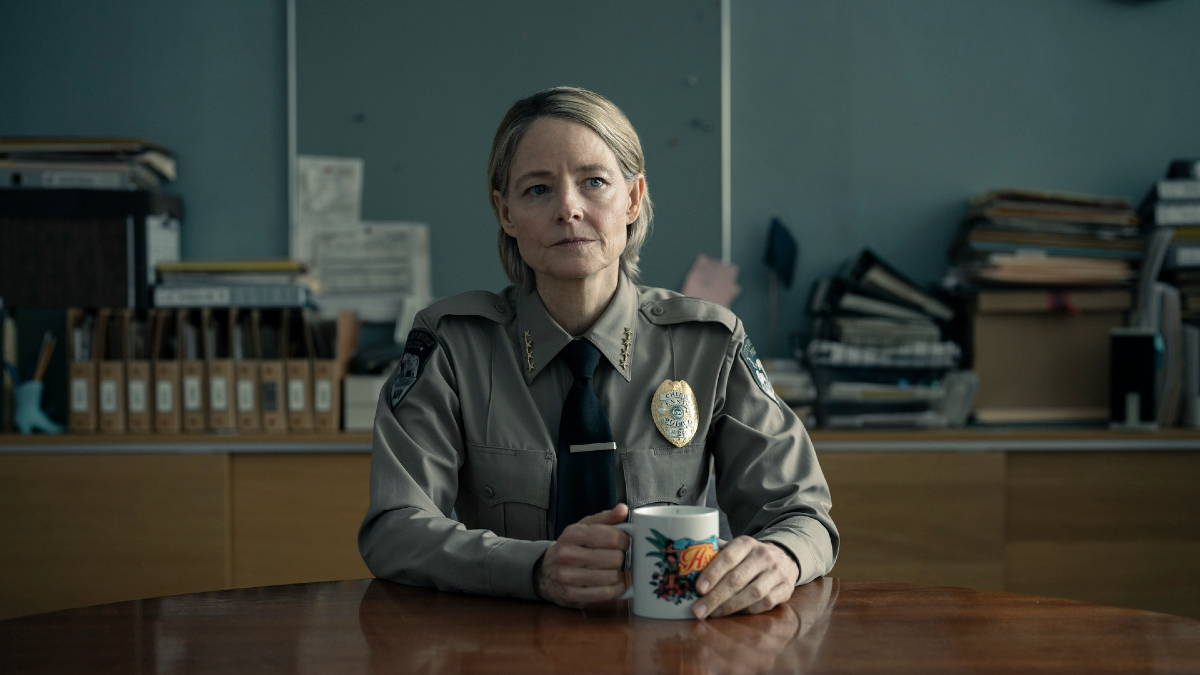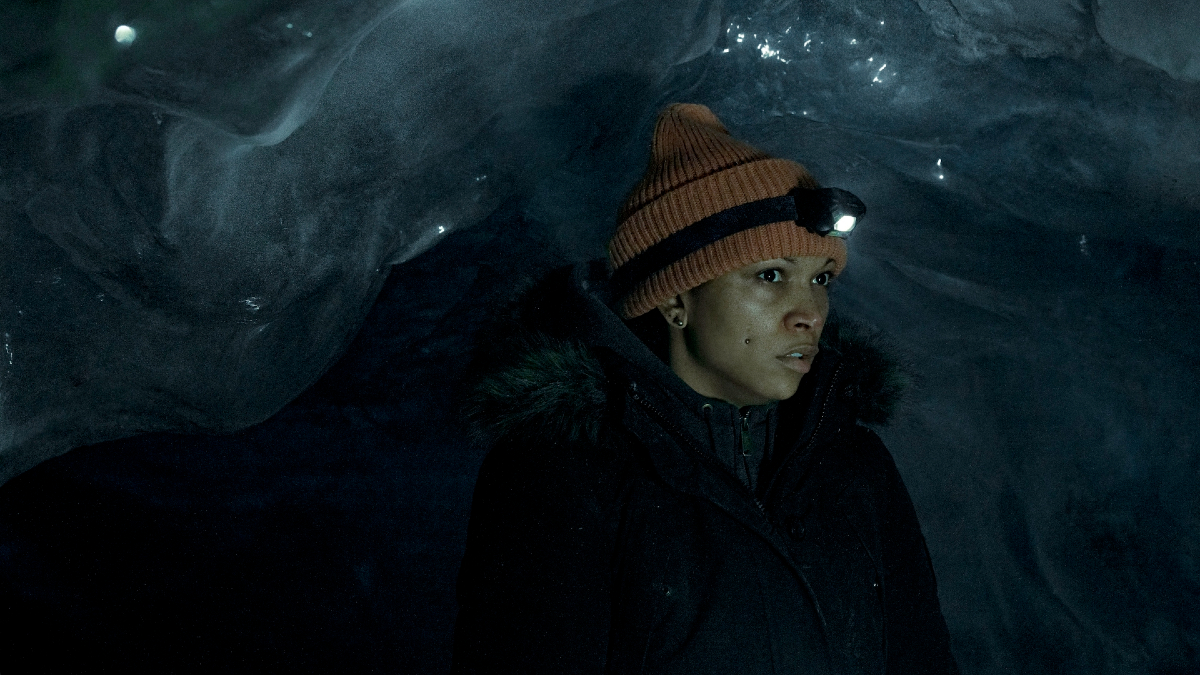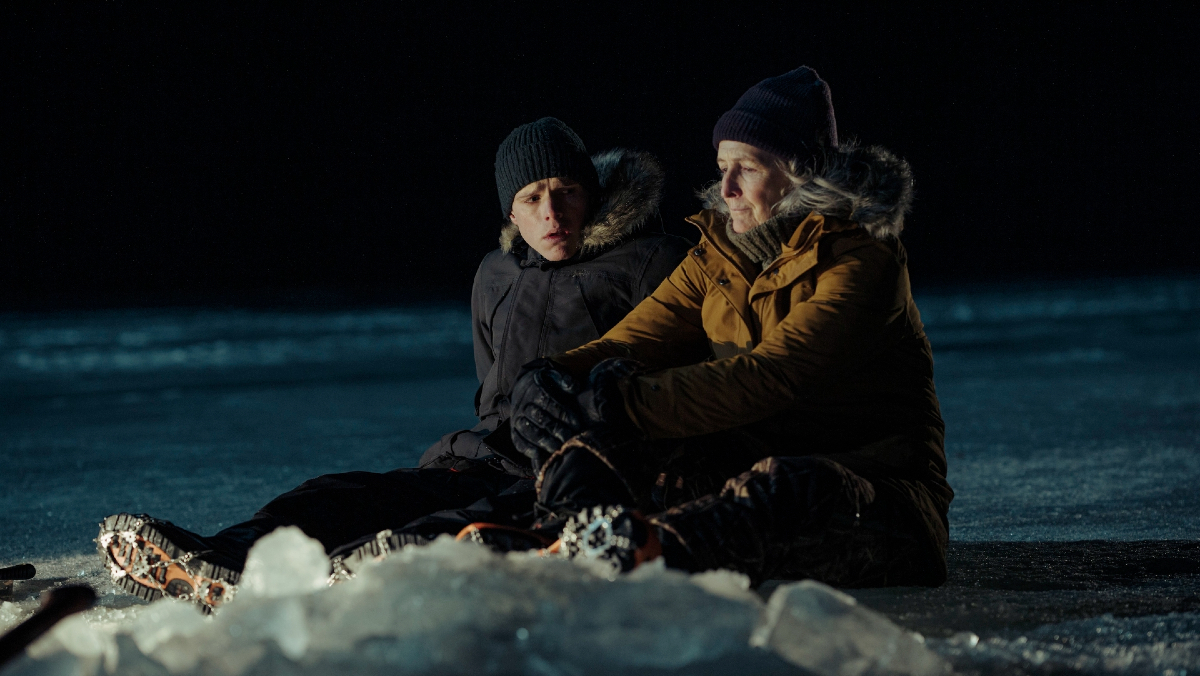In the ‘True Detective: Night Country’ Finale, Stories Are All That’s Left

Near the end of the True Detective: Night Country finale, Danvers tells Navarro that “Some questions just don’t have answers.” But by the time they’re sitting in Beatrice’s home, it’s apparent that some stories are often more satisfying than answers alone.
To get to the truth—about Annie K., the Tsalal men, and what’s really going on at that research station—Navarro (Kali Reis) and Danvers (Jodie Foster) have to enter the belly of a primitive beast, almost literally: they go (and then fall) beneath the ice and into the vast network of caves where AWOL researcher Raymond Clark leads them into a man made cavern. A prehistoric skeleton hovers in a spiral, frozen into the ice above, haunting a cavern filled with research equipment and samples. There’s a ladder leading up and into the research station via a hatch, which Clark used to escape on the night his colleagues died.

What happened to Annie? (Clark’s version)
Navarro and Danvers tangle with Clark before strapping him into a chair and forcing him to listen, on a loop, to the video Annie recorded right before she died. When Clark finally relents, he tells the story of what happened that night—his version.
Stories are amorphous; like gas, they take the shape of whatever container they’re in. Depending on the storyteller, the narrative can be refined and reshaped or reduced to its molecular components and reconstructed, sometimes with missing parts. In his telling, Clark confesses that the Tsalal men did more than just distort pollution data from Silver Sky’s mining activities; they encouraged more mining to facilitate the water pollution necessary to loosen the ice, making their extraction of a primitive organism and its valuable DNA much easier. Annie discovered the hidden research cavern and, because she destroyed their expensive equipment and precious samples, the men—all of them—murdered her. But Clark adds a “not all men” disclaimer, telling Navarro and Danvers that of course he didn’t participate in Annie’s murder. He could never hurt her. He loved her. His mouth tells one story, but his memory belies another: As Clark sobbed over her motionless body, Annie came to, and he finished the job.
Night Country spends much of “Part 6” in the research station with Navarro and Danvers experiencing their own long, dark night of the soul. Clark chooses to die in the blizzard, and the power goes out at the station, forcing Navarro and Danvers to build a fire and tell the only stories they have left. Navarro chooses to take comfort in the voices that call her to walk out onto the ice. “There is more than this, Liz,” Navarro insists. “There is so much more than just this.” When Navarro tries to give Danvers a message from her dead son, Holden, Danvers shuts her down and walks away, leading to the series’ most supernatural sequence yet: Navarro leaves the station and wanders across the ice, but in her mind she’s in a sunny desert landscape accompanied by her mother, who finally whispers her Iñupiat name: Siqiññaatchiaq.
Meanwhile, as Danvers pursues Navarro, she hears Holden crying out and sees him trapped beneath the ice. Danvers breaks the surface and plunges into the freezing water, but Navarro drags her out just in time. Back inside, as Danvers slowly comes around, she asks Navarro what Holden said to her. “He sees you,” Navarro says, and Danvers finally melts. She’s spent every day since her son died holding every fiber of her being in a fixed contraction, concerned only with asking the right questions, the ones that have answers—because Danvers knows the excruciating pain that comes from unanswerable questions, and the futility of asking over and over again.

While Danvers and Navarro are busy pulling this existential train into the station, another story is beginning for Peter Prior (Finn Bennett), who does as Navarro instructs and takes his father’s body to Rose Aguineau (Fiona Shaw). Peter digs a hole in the ice to send Hank’s corpse down into the sea, after which Rose says that he might think the worst part is over now, but it’s not. It’s what comes after, “Forever,” Rose says, “is the worst fucking part.” At least his wife, Kayla, is happy that Peter finally made a choice for himself?
What happened to the researchers? (Her version)
Back in the station, Danvers and Navarro are still puzzling over how the men died. Clark maintains that he doesn’t know what happened because he went in the hatch and held it closed while listening to the men scream. Danvers is suddenly struck by the realization that they’ve been asking the wrong question: It’s not “How did Annie K. die?” it’s “Who else saw it happen?” She quickly finds a handprint missing two fingers, just like the print found on the mens’ clothing, folded near the corpsicle. That print belongs to Blair, who lost her fingers at the crab factory—something we learned in the very first episode.
Danvers is always concerned with asking the right questions, but she often ignores the voices that might guide her in the right direction. The Indigenous women of Ennis see and hear everything, but they are rarely seen or heard. They work as housekeepers and in laundromats and doing the sort of service labor that makes them even more invisible—a fact that they’ve used to their benefit in collecting evidence about Annie K.’s murder.
Navarro and Danvers pay Blair a visit at Beatrice Malee’s home and, as more of the local Indigenous women slowly join them in the living room, Beatrice tells another story. The night the researchers died, the women descended upon the research station, forced the men into a freight container, and took them out on the ice. The “Justice Ladies,” as Night Country creator Issa López calls them, told the men to take off their clothes and walk into the darkness. They didn’t kill the researchers; they offered the men up to “Her”—be it Mother Nature, the collective spirit of the missing and dead Indigenous women, or Annie herself—to decide. Maybe, as Beatrice suggests, She “ate their fucking dreams from the inside out and spit their frozen bones.” (Easily the best line in all of Night Country.)
“But it’s just a story,” Beatrice concludes. Navarro and Danvers accept it, using Anchorage’s “official” version of events—the men died in a freak slab avalanche—as cover.

Time is a flat circle
I found myself occasionally worried about Night Country‘s references to True Detective season 1, but Issa López’s compelling storytelling never let these become distractions. Instead, the spirals and straw dolls and Tuttle namedrops appeared as if woven into the frozen atmosphere, as inextricable from Ennis as the ice itself.
During his tangent about the mysterious, supernatural “She” in the finale, Clark delivers the series’ most overt callback, and the one some viewers were likely waiting for. She, Clark says, is Annie. It doesn’t matter that Otis Heiss suffered similar injuries on the ice before Annie was murdered because time is a flat circle. Annie has always been alive and she’s always been dead. And that’s when Night Country fully coalesced for me: this is a story about stories.
The story of Annie is one that’s been told many times before, about many Annies and the men who destroy them. In fiction, there are only so many stories to tell, which is why we often engage with how the story is told rather than what the story is telling. In the reality of Night Country—and in our own world—there are also only so many stories and only so many tellers, and so often it’s the same horrible story over and over and over again. The colonizers and capitalists co-opt and corrupt the land; men become so afraid of women—their power, their seeing, their knowing—that they violently destroy them; the cops collect fragments and fit them together to make up one of the only stories they know how to tell.
There are also stories that are not ours to tell, and we’ll only ever hear them if we listen. It’s not about asking the right question; it’s about who you ask.
The final episode of Night Country ends with a montage of scenes: In another callback to True Detective season 1, Danvers sits at a table in front of two investigators and a video camera, reciting the official version of events. What happened to Hank? He killed Otis Heiss and died in an accident on the ice while trying to dispose of the body. What happened to Annie? The researchers killed her, and then they died in a bizarre avalanche. What happened to Navarro? And on this question, we linger. Danvers’ mouth tells us one story—”I doubt she’ll be found out on the ice”—while her memories—or maybe they’re hopes, or possibly peeks into the future—belie another.
Navarro made good on her promise to disappear, but she left behind Holden’s one-eyed polar bear and a phone with Clark’s confession to the murder and the true extent of the mine’s pollution. Danvers sits in a sunlit home, sipping tea and filling out a crossword before heading onto a deck with a beautiful view. Navarro quietly joins her, perhaps making good on her promise to Danvers, that if she ever disappeared, she’d try to come back. Danvers looks to Siqiññaatchiaq, whose name Beatrice helpfully translated: “the return of the sun after the long darkness.”
(featured image: HBO)
Have a tip we should know? [email protected]
